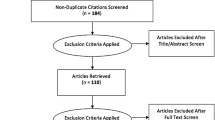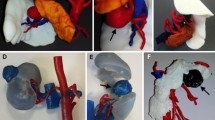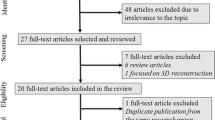Abstract
Background
Three-dimensional printing technology is rapidly changing the way we produce all sort of objects, having also included medical applications. We embarked in a pilot study to assess the value of patient-specific 3-D physical manufacturing of spleno-pancreatic anatomy in helping during patient’s counseling and for preoperative planning.
Methods
Twelve patients scheduled for a laparoscopic splenectomy underwent contrast CT and subsequent post-processing to create virtual 3-D models of the target anatomy, and 3-D printing of the relative solid objects. The printing process, its cost and encountered problems were monitored and recorded. Patients were asked to rate the value of 3-D objects on a 1–5 scale in facilitating their understanding of the proposed procedure. Also 10 surgical residents were required to evaluate the perceived extra value of 3-D printing in the preoperative planning process.
Results
The post-processing analysis required an average of 2; 20 h was needed to physically print each model and 4 additional hours to finalize each object. The cost for the material employed for each object was around 300 euros. Ten patients gave a score of 5, two a score of 4. Six residents gave a score of 5, four a score of 4.
Conclusions
Three-dimensional printing is helpful in understanding complex anatomy for educational purposes at all levels. Cost and working time to produce good quality objects are still considerable.



Similar content being viewed by others
References
Sakamoto T (2014) Roles of universal three-dimensional image analysis devices that assist surgical operations. J Hepatobiliary Pancreat Sci 4:230–234
Hoy MB (2013) 3D printing: making things at the library. Med Ref Serv Q 32:94–99
Kim S, Golding M, Archer RH (2012) The application of computer color matching techniques to the matching of target colors in a food substrate: a first step in the development of foods with customized appearance. J Food Sci 77:S216–S225
Murphy SV, Atala A (2014) 3D bioprinting of tissues and organs. Nat Biotechnol 32:773–785
Kappers AM (2011) Human perception of shape from touch. Philos Trans R Soc Lond B Biol Sci 366:3106–3114
Yushkevich PA, Piven J, Cody Hazlett H, Gimpel Smith R, Ho S, Gee JC, Gerig G (2006) User-guided 3D active contour segmentation of anatomical structures: significantly improved efficiency and reliability. Neuroimage 31:1116–1128
Poulin EC, Thibault C (1993) The anatomical basis for laparoscopic splenectomy. Can J Surg 36:484–488
Pietrabissa A, Morelli L, Peri A, Pugliese L, Zonta S, Dionigi P, Mosca F (2011) Laparoscopic treatment of splenomegaly: a case for hand-assisted laparoscopic surgery. Arch Surg 146:818–823
Ferrari V, Megali G, Troia E, Pietrabissa A, Mosca F (2009) A 3-D mixed-reality system for stereoscopic visualization of medical dataset. IEEE Trans Biomed Eng 56:2627–2633
Nilsson T, Hedman L, Ahlqvist J (2007) Visual-spatial ability and interpretation of three-dimensional information in radiographs. Dentomaxillofac Radiol 36:86–91
Meijer F, Van der Lubbe RH (2011) Active exploration improves perceptual sensitivity for virtual 3D objects in visual recognition tasks. Vision Res 51:2431–2439
Fleming RW, Holtmann-Rice D, Bulthoff HH (2011) Estimation of 3D shape from image orientation. Proc Natl Acad Sci USA 108:20438–20443
Kappers AM (2011) Human perception of shape from touch. Philos Trans R Soc Lond B Biol Sci 366:3106–3114
Norman JF, Norman HF, Clayton AM, Lianekhammy J, Zielke G (2004) The visual and haptic perception of natural object shape. Percept Psychophys 66:342–351
Frisoli A, Solazzi M, Reiner M, Bergamasco M (2011) The contribution of cutaneous and kinesthetic sensory modalities in haptic perception of orientation. Brain Res Bull 30:260–266
Ernst MO, Newell FN (2007) Multisensory recognition of actively explored objects. Can J Exp Psychol 6:242–253
Wijntjes MW, Volcic R, Pont SC, Koenderink JJ, Kappers AM (2009) Haptic perception disambiguates visual perception of 3D shape. Exp Brain Res 193:639–644
Gross BC, Erkal JL, Lockwood SY, Chen C, Spence DM (2014) Evaluation of 3D printing and its potential impact on biotechnology and the chemical sciences. Anal Chem 86:3240–3253
McMenamin PG, Quayle MR, McHenry CR, Adams JW (2014) The production of anatomical teaching resources using three-dimensional (3D) printing technology. Anat Sci Educ. doi:10.1002/ase.1475
Rengier F, Mehndiratta A, von Tengg-Kobligk H, Zechmann CM, Unterhinninghofen R, Kauczor HU, Giesel FL (2010) 3D printing based on imaging data: review of medical applications. Int J Comput Assist Radiol Surg 5:335–341
Zein NN, Hanouneh IA, Bishop PD, Samaan M, Eghtesad B, Quintini C, Miller C, Yerian L, Klatte R (2013) Three-dimensional print of a liver for preoperative planning in living donor liver transplantation. Liver Transpl 19:1304–1310
Silberstein JL, Maddox MM, Dorsey P, Feibus A, Thomas R, Lee BR (2014) Physical models of renal malignancies using standard cross-sectional imaging and 3-dimensional printers: a pilot study. Urology 84:268–273
Beamond BM, Beischer AD, Brodsky JW, Leslie H (2009) Improvement in surgical consent with a preoperative multimedia patient education tool: a pilot study. Foot Ankle Int 30:619–626
Lee J, Woo J, Xing F, Murano EZ, Stone M, Prince JL (2014) Semi-automatic segmentation for 3D motion analysis of the tongue with dynamic MRI. Comput Med Imaging Graph (Epub ahead of print). doi:10.1016/j.compmedimag.2014.07.004
Megali G, Ferrari V, Freschi C, Morabito B, Cavallo F, Turini G, Troia E, Cappelli C, Pietrabissa A, Tonet O, Cuschieri A, Dario P, Mosca F (2008) EndoCAS navigator platform: a common platform for computer and robotic assistance in minimally invasive surgery. Int J Med Robot 4:242–251
Acknowledgments
The authors would like to thank Miss Nicole Shockcor for reviewing the manuscript.
Disclosures
Prof. Andrea Pietrabissa, Dr. Eng. Stefania Marconi, Dr. Andrea Peri, Dr. Luigi Pugliese, Dr. Emma Cavazzi, Dr. Alessio Vinci, Mrs. Marta Botti and Prof. Ferdinando Auricchio have no conflict of interest or financial ties to disclose.
Author information
Authors and Affiliations
Corresponding author
Rights and permissions
About this article
Cite this article
Pietrabissa, A., Marconi, S., Peri, A. et al. From CT scanning to 3-D printing technology for the preoperative planning in laparoscopic splenectomy. Surg Endosc 30, 366–371 (2016). https://doi.org/10.1007/s00464-015-4185-y
Received:
Accepted:
Published:
Issue Date:
DOI: https://doi.org/10.1007/s00464-015-4185-y




